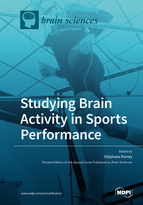Studying Brain Activity in Sports Performance
A special issue of Brain Sciences (ISSN 2076-3425). This special issue belongs to the section "Systems Neuroscience".
Deadline for manuscript submissions: closed (30 September 2020) | Viewed by 74223
Special Issue Editor
Interests: changes in the brain-motor relationships during exercise in humans; fatigue; brain stimulation; near infrared spectroscopy
Special Issue Information
Dear Colleagues,
The main goal of systems neuroscience is to understand how the brain controls behavior. With the advent of neuroimaging technologies and transcranial stimulation protocols, it has become possible to study the functional brain correlates of behavior and underlying cognitive and sensorimotor functions’ performance. Acute and chronic exercises are associated with changes in brain structure and function. Unfortunately, while neuroscience can allow us to go inside the brain and investigate the primal causes of behavior, there is still a lack of applying neuroscientific findings in the context of sports performance.
The purpose of this Special Issue is to collect articles that explore or discuss how brain functions evolve during and after exercise in healthy people when experienced multiple times throughout the week, over several months to many years. Original research studies using various experimental measures (e.g., transcranial stimulation, neuroimaging methods, electromyography and spinal reflexes), in various states (e.g., fatigued, nonfatigued, and resting) during different categories of sports (endurance, strength, sporting skills) or the most popular Olympic sports (running, cycling, rowing, tennis, fencing, etc.) are encouraged. Original research articles or brief, focused reviews are acceptable.
Prof. Dr. Stéphane Perrey
Guest Editor
Manuscript Submission Information
Manuscripts should be submitted online at www.mdpi.com by registering and logging in to this website. Once you are registered, click here to go to the submission form. Manuscripts can be submitted until the deadline. All submissions that pass pre-check are peer-reviewed. Accepted papers will be published continuously in the journal (as soon as accepted) and will be listed together on the special issue website. Research articles, review articles as well as short communications are invited. For planned papers, a title and short abstract (about 100 words) can be sent to the Editorial Office for announcement on this website.
Submitted manuscripts should not have been published previously, nor be under consideration for publication elsewhere (except conference proceedings papers). All manuscripts are thoroughly refereed through a single-blind peer-review process. A guide for authors and other relevant information for submission of manuscripts is available on the Instructions for Authors page. Brain Sciences is an international peer-reviewed open access monthly journal published by MDPI.
Please visit the Instructions for Authors page before submitting a manuscript. The Article Processing Charge (APC) for publication in this open access journal is 2200 CHF (Swiss Francs). Submitted papers should be well formatted and use good English. Authors may use MDPI's English editing service prior to publication or during author revisions.
Keywords
- Exercise
- Transcranial stimulation
- Fatigue
- Neuroimaging
- Training
- Neural plasticity







